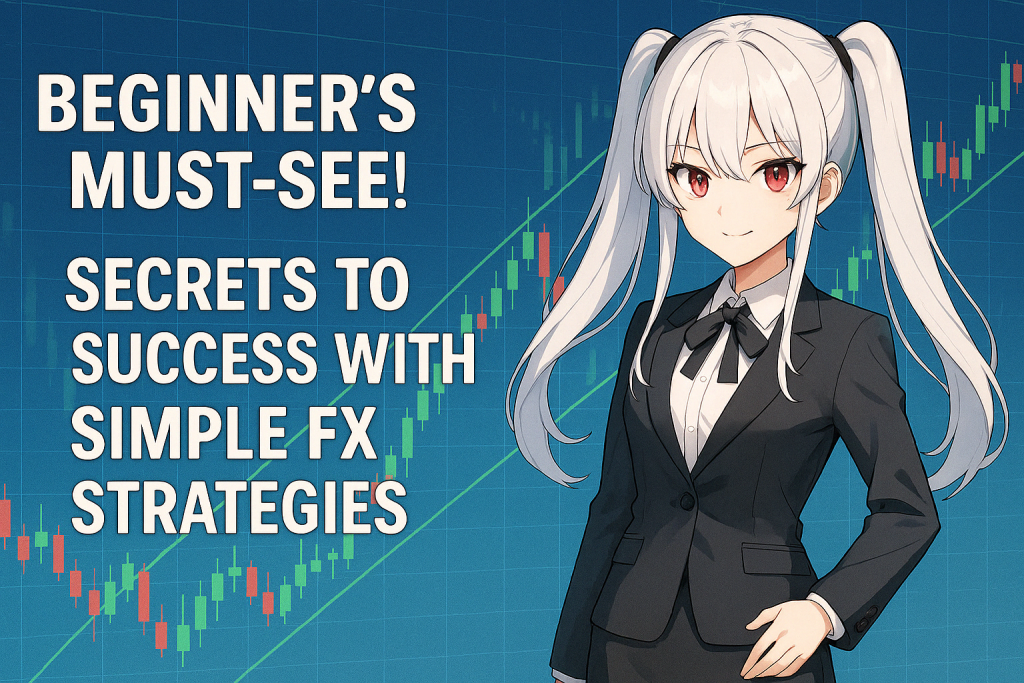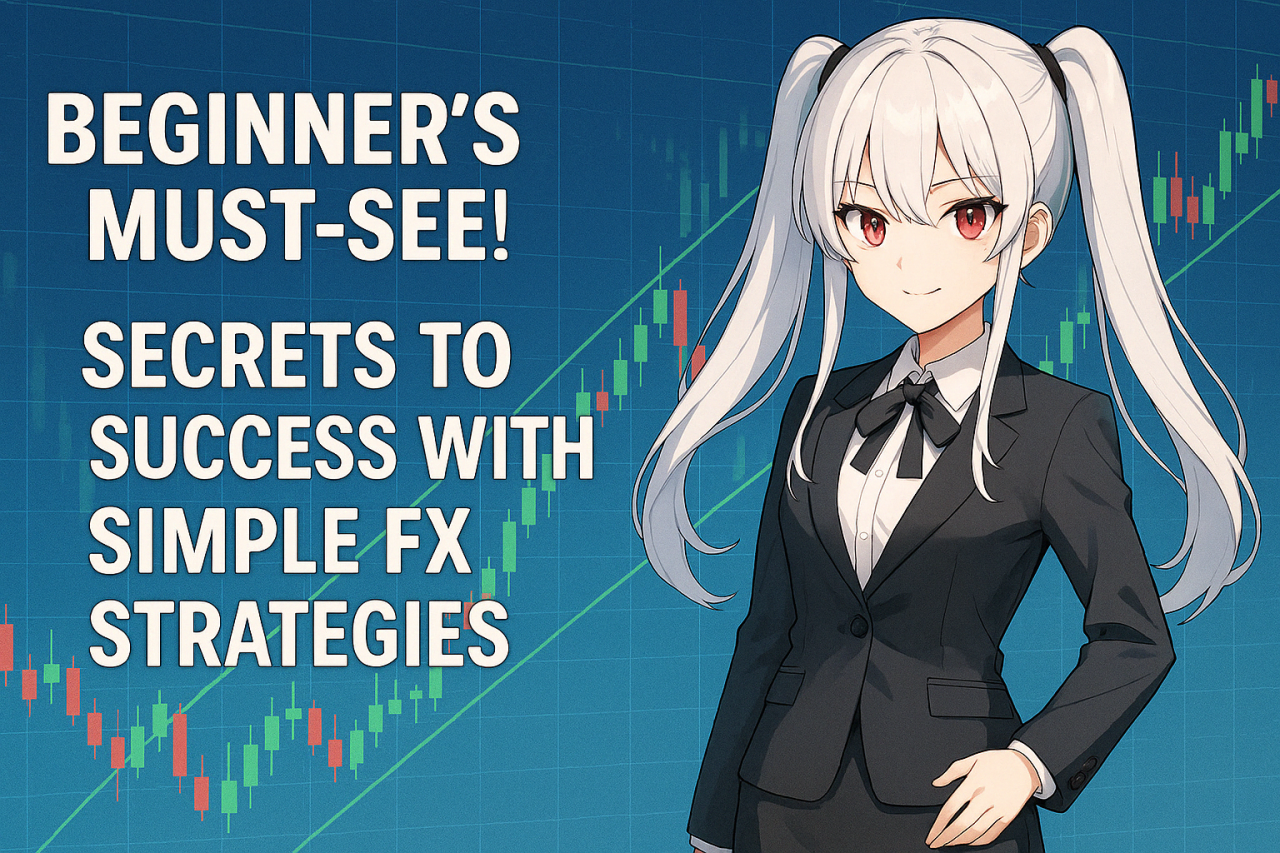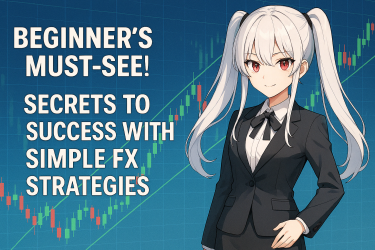FX trading can feel daunting for beginners, but by using simple strategies, you can gradually improve. In this blog, we will carefully explain the basics of simple FX strategies, practical techniques, how to choose appropriate time frames, and more, so beginners can effectively start FX trading. Please learn and apply these simple yet reliable methods in practice.
- 1 1. What is the FX Simple Method? A Basic Explanation Easy for Beginners
- 2 2. Increase Your Win Rate! 5 Recommended Simple Trade Methods
- 3 3. Choosing Timeframes Suitable for Short-Term and Long-Term Charts and Simple Strategies
- 4 4. Basics of Risk Management to Avoid Failure in Trading
- 5 5. Creating a Trading Environment to Practice Simple Strategies
- 6 Summary
- 7 Frequently Asked Questions
- 8 Reference Sites
1. What is the FX Simple Method? A Basic Explanation Easy for Beginners
The FX Simple Method is an approach that eliminates complex analysis and uses basic techniques to conduct FX trading. This style is characterized by being easy for beginners to understand and having a low barrier to practice. Let’s explore the basics of the FX Simple Method in detail.
Features of the Simple Method
The FX Simple Method has the following attractive features.
Use of intuitive analysis tools: The simple method uses easy-to-understand tools such as candlestick charts, moving averages, and trend lines. This allows trade decisions to proceed smoothly, so beginners can feel at ease.
Clear rule setting: The simple method does not require complex rules, and the criteria for trading decisions are clear. This helps maintain composure and trade without being swayed by emotions.
Reduced psychological stress: Because advanced analysis and large amounts of information are less stressful, traders can more easily reduce mental burden.
Basic Learning Content
To understand the FX Simple Method, beginners need to acquire solid basic knowledge. The following are key points to keep in mind as fundamental elements:
Currency pair: Refers to the combination of currencies that are traded. For example, the pair of the U.S. dollar and Japanese yen (USD/JPY) is commonly known.
pips (pips): The smallest unit of price movement in trading, essential for measuring profits and losses. Understanding this allows you to accurately evaluate trade outcomes.
Leverage: A mechanism that allows large trades with a small amount of capital, but it also carries risk, so selecting appropriate leverage is important.
Spread: The difference between the bid and ask prices. Choosing currency pairs with a narrow spread can reduce trading costs.
Advantages of the Simple Method
The FX Simple Method is particularly noteworthy because it can be started easily even by beginners. The specific advantages are as follows:
Convenience: Because it does not rely on difficult theories or indicators, you can start trading smoothly. Additionally, you are unlikely to feel a heavy burden while learning the basics.
Immediate applicability: You can apply what you have learned directly to trading, making it easier to deepen your understanding while gradually gaining experience.
Support for growth: Mastering the simple method builds a solid foundation that allows you to challenge more complex analytical techniques in the future.
The FX Simple Method is positioned as a very convenient introduction for beginners. While solidifying the basics, use the freedom gained from simplicity to evolve your own trading style.
2. Increase Your Win Rate! 5 Recommended Simple Trade Methods
In FX trading, using simple methods is very effective for increasing win rates. Below we introduce simple trade methods that are easy for beginners to adopt and effective. These methods, while simple, are widely accepted in the market and are popular among many traders.
1. Moving Average Crossover
Moving averages help visualize trends. Use the crossover point of short-term and long-term moving averages as an entry signal. Specifically, if the short-term moving average crosses above the long-term moving average, buy; if it crosses below, sell. This method is especially effective during trend formation.
2. RSI (Relative Strength Index)
RSI is an indicator that shows overbought or oversold conditions based on price movements over a period. Generally, values above 70 indicate overbought, below 30 indicate oversold. Based on this, sell when it exceeds 70, buy when it falls below 30. It’s simple and easy to understand, but be cautious of movements that stay in the trend.
3. Bollinger Bands
Bollinger Bands indicate whether the price stays within a certain standard deviation. Contact with the upper band signals a sell, contact with the lower band signals a buy. However, pay attention to band expansion and contraction, and use them within the trend rather than against it.
4. Fibonacci Retracement
Fibonacci retracement is a very simple method to predict trend reversal points. Connect the high and low of the price to identify key retracement levels. The 38.2%, 50%, and 61.8% lines are often highlighted as rebound points, so observe price movements in these ranges to discern entry signals.
5. Support and Resistance Lines
Support lines (where price struggles to fall) and resistance lines (where price struggles to rise) are part of basic technical analysis in trading. Draw these lines from historical price data and target entry or exit points where the price is likely to rebound upon contact.
These simple trade methods can help improve win rates when used strategically. Their clarity and simplicity make them easy for beginners to handle and can yield effective results. While thoroughly preparing before trading and managing risk, apply these methods in practice.
3. Choosing Timeframes Suitable for Short-Term and Long-Term Charts and Simple Strategies
In FX trading, choosing the timeframe is very important. Especially when using simple strategies, selecting an appropriate timeframe can improve your win rate. Here, we explain the characteristics of short-term and long-term charts and the optimal timeframes for simple strategies.
Features and Precautions of Short-Term Charts
Short-term charts (1-minute, 5-minute, 15-minute, etc.) can capture rapid price movements, so they may seem like an attractive option at first glance. However, short-term trading also carries its own unique risks.
Beware of false signals: On short-term charts, buy/sell signals from simple strategies often reverse, and the price may move against expectations. For example, even if the price falls below the moving average, it may rebound.
Rapid decision-making is required: To succeed on short-term charts, quick reactions are essential. For beginners, this rapid judgment can be difficult, so careful trading is necessary.
Advantages of Long-Term Charts and How to Apply Them
On the other hand, long-term charts (1-hour, 4-hour, daily, etc.) can capture relatively stable trends. This makes simple strategies more effective.
Understanding the trend: Long-term charts more accurately reflect past trends, allowing you to grasp the market’s big picture. For example, after observing the daily trend, entering on a short-term chart can be effective.
Maintaining mental composure: Trades based on long-term charts are less affected by instantaneous price swings, allowing for calmer decisions. Since trade results can be reviewed over a relatively long period, you feel less rushed.

Choosing the Appropriate Timeframe
To effectively use simple strategies, it is important to choose a timeframe that matches your trading style and lifestyle. Below are points to help you find the right timeframe for yourself.
Consider your lifestyle: If you want to day trade, you need to spend a lot of time on trading, but if your time is limited, you might choose longer timeframes such as swing trading or position trading.
Selecting a trading style: If you prefer short-term styles like scalping, it is common to use short-term charts such as 15-minute or 1-minute. However, always check the long-term trend and aim to reduce risk.
Timeframes based on market conditions: When the market is calm, long-term trading is often suitable; when volatility is high, short-term charts may be more advantageous. Continuously monitor market conditions and adjust timeframes flexibly.
By taking these points into account, you can increase the success rate of FX simple strategies.
4. Basics of Risk Management to Avoid Failure in Trading
When trading with the FX Simple method, risk management is an essential element for achieving success. In particular, the simplicity of the method can lead to a lax attitude toward risk. However, without planned and effective risk management, it is very difficult to generate profits over the long term. Here, we will delve into the basics of risk management that FX traders should understand.
Key Elements of Risk Management
Setting Stop-Loss Rules
A stop-loss is a fundamental technique to limit the impact when a position incurs a loss. When the pre-set loss limit is reached, you should close the position promptly. It is generally recommended to target a loss of 1% to 2% of your capital.Choosing an Appropriate Lot Size
The lot size you use when trading must be chosen carefully. Trading with large lots exposes you to the risk of significant losses from small price movements. Selecting the right lot size allows you to manage risk effectively.Managing Leverage
Leverage is a tool that can amplify profits, but it also increases risk. For those new to FX, starting with lower leverage is ideal, enabling safer trading.
Methods for Managing Investment Capital
Fixed Ratio Method
This approach sets the lot size based on a fixed percentage of your investment capital. As your capital grows, the lot size increases, but if losses persist, you must reduce the lot size, necessitating careful management.Percent Risk Method
This method limits the risk per trade to a set percentage of your capital. It helps maintain stable trading, but since the lot size doesn’t increase even as capital grows, profit growth may be gradual.
Managing Psychological Risk
In FX trading, the psychological aspect is also very important. Traders who use simple methods often take unnecessary risks out of overconfidence in their ability to win.
Controlling Emotions
Continuing to make highly profitable trades can lead to overconfidence. It is essential to adhere to trading rules and make calm decisions.Clarifying the Trading Plan
Before you trade, develop a solid plan for the day and gather the necessary data. Acting according to that plan helps you make decisions that are not swayed by emotion.
Risk management is an essential element for achieving success with the FX Simple method. By understanding and practicing these basics, you can conduct safe and effective trading.
5. Creating a Trading Environment to Practice Simple Strategies
How you choose a trading account directly impacts success. Focus on the following points.
Choosing a Trading Account
How you choose a trading account directly impacts success. Focus on the following points.
- Spread: To keep transaction costs low, choose a broker with the narrowest spread possible. This makes it easier to earn profits.
- Trading Tools: Selecting an intuitive platform allows for stress‑free trading. Find one that suits you.
- Support System: Choosing a provider that offers quick support when problems arise gives peace of mind.
Preparing Chart Analysis Tools
To effectively implement simple strategies, it’s essential to have only the minimum necessary analysis tools. We recommend using the following tools.
- MT4/MT5: A multifunctional, widely loved chart analysis tool used by traders worldwide. It also boasts ease of use.
- TradingView: An excellent platform accessible online, offering real‑time data and a variety of indicators.
Simple Chart Settings
When implementing simple strategies, complex indicators are unnecessary. You can create a clean chart with settings like the following.
- Basic Moving Averages: Use short‑ and long‑term moving averages to visually capture the trend.
- Trend Lines: Drawing support and resistance lines clarifies price reversal points.
This makes it easier to grasp information visually and allows for intuitive decision‑making.
Information Collection and Management
To optimize your trading environment, gathering information from reliable sources is essential. While selecting information, keep the following points in mind.
- Unbiased Information: Incorporate diverse data and eliminate bias.
- Filtering: Selecting only the necessary information is crucial. Especially for beginners, who tend to fall into information overload, we recommend focusing on basic sources.
Regular Environment Review
Review the built trading environment regularly. By revisiting the tools and information sources in line with market conditions and your skill improvement, you can achieve more effective trading. Incorporating new tools and methods expands your trading options.
To succeed with simple strategies, carefully setting up an effective trading environment is fundamental. Building a solid environment makes it easier to focus on trading and achieve better results.
Summary
FX Simple Method is an attractive approach that is easy for beginners to tackle and does not require complex analysis. In this article, we explained in detail the characteristics of the Simple Method, representative techniques, how to choose time frames, the basics of risk management, and how to set up an effective trading environment. By understanding these basics and applying them in practice, even beginners can steadily build their skills. Maximize the freedom hidden within simplicity and find a trading style that suits you.
Frequently Asked Questions
What are the features of the FX Simple Method?
FX Simple Method is an approach that eliminates complex analysis and conducts FX trading using basic techniques. By using intuitive analysis tools and setting clear rules, it becomes easy to understand and approachable even for beginners. Additionally, stress from advanced analysis and large amounts of information is reduced, easing the trader’s psychological burden.
Does using the Simple Method increase win rates?
Yes, by strategically operating a simple method, you can expect an increase in win rates. Simple trading techniques such as moving average crossovers, RSI, Bollinger Bands, Fibonacci retracements, and support/resistance lines are easy for beginners to handle and can yield effective results.
What timeframes are suitable for the Simple Method?
To effectively use the Simple Method, it is important to choose a timeframe that matches your trading style and lifestyle. Short-term charts require quick decision-making, while long-term charts make it easier to capture more stable trends and provide mental space. Considering the trader’s situation and market environment, it is important to flexibly adjust the timeframe.
Is risk management important even with the Simple Method?
Yes, risk management is an essential element in all FX trading, including the Simple Method. By setting stop-loss rules, selecting appropriate lot sizes, and managing leverage, you can earn profits in the long term. Additionally, controlling emotions and clarifying trade plans are important aspects of psychological risk management.
Reference Sites
FX取引は複雑で難しいというイメージがあるかもしれませんが、シンプルな手法でも利益を上げることは可能です。 この記事で…
FXの取引手法は、売買するときのルール設定と切っても切れない関係にあります。本記事では、FXの取引手法の意味や種類、相場…













